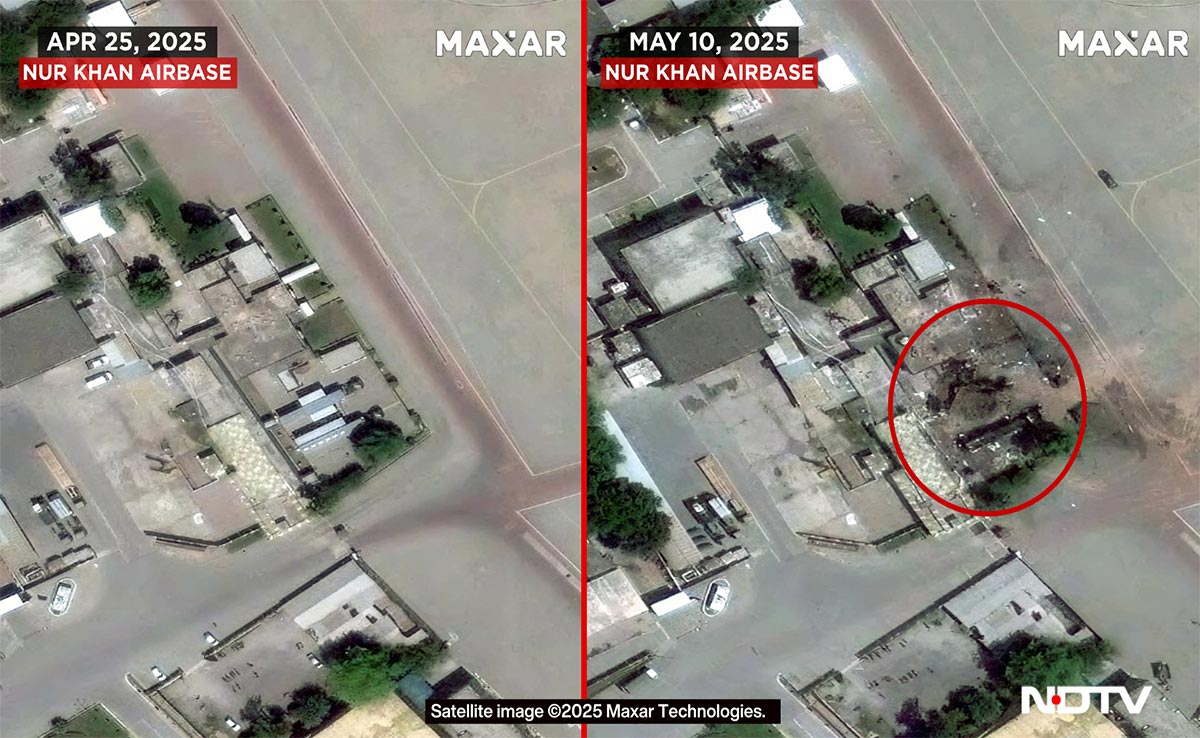
New high-resolution satellite images, accessed by NDTV, show extensive damage to the Murid air base of Pakistan, showing a three-metre-wide crater just 30 metres from an underground facility of the Pakistan Air Force and damage to the rooftop of a structure adjacent to unmanned aerial vehicle hangars.
The first image shows a massive crater at the air base after strikes.
"The Strike is visible at the most guarded complex within Murid Airbase. The approximately three-meter-wide munition impact crater is just 30 meters north of one of the two entrances to a likely underground facility," says Damien Symon, a geospatial intelligence researcher associated with the Intel Lab, known for his work analysing satellite imagery to monitor military and infrastructure developments.
"This complex is heavily protected with double fencing, its own watchtowers and access control indicating its high-value nature as a target. The earth-protected entrances suggest this site might serve as storage for special equipment or as a hardened operational shelter for personnel, capable of withstanding heavy bombardment," he added.

The Strike is visible at the most guarded complex within Murid Airbase. With inputs: Damien Symon. Satellite image ©2025 Maxar Technologies. High-res image here
NDTV accessed an image from April 16 (Image 1), showing the undamaged building at Murid, a Forward Operating Base of Pakistan. The post-strike (image 2) from May 10 shows damage to the building. Mr Symon said, "Structural damage is evident at this facility, believed to serve as a command-and-control node near the UAV complex of the airbase. A portion of the roof has collapsed inward, and the outer walls also exhibit visible deterioration, likely from impact-related stress. A strike like this could've also caused damage within the upper floors of the building as well."

Pre-strike image from April 16 shows the undamaged structure. With inputs: Damien Symon
Satellite image ©2025 Maxar Technologies

Post-strike image from May 10 shows structural damage at the facility believed to serve as a command and control centre near a UAV complex. With inputs: Damien Symon. Satellite image ©2025 Maxar Technologies. High-res image here
The Murid air base is 150 kilometres from the Line of Control in Jammu and Kashmir. It is situated in Pakistan's Chakwal, supporting the Sargodha air base and the Nur Khan air base in Rawalpindi.
Both were struck by India on May 10, along with eight other bases. India struck deep inside Pakistan, its response was "measured and calibrated."
New Images Of Nur Khan Air Base
Nur Khan is a strategic air base situated between Rawalpindi and Islamabad - the two nerve centres of Pakistan. The former is the headquarters of the Pakistan military, and the latter is the political power centre of the country. Satellite imagery from April 25, taken almost two weeks before the strikes, shows the facility and the undamaged trucks, says Mr Symon.

Pre-strike image from April 25 of the Nur Khan air base shows undamaged trucks. With inputs: Damien Symon. Satellite image ©2025 Maxar Technologies. High-res image here
Satellite imagery from May 10 shows two trailer trucks, believed to be command and control facilities, having been destroyed by a pinpoint-accurate Indian strike. Post-strike image from May 17 indicates that Pakistani authorities cleared the area around the site of the attack, he added.

Post-strike image from May 10 shows damage, truck debris and partial damage visible to an adjacent building. With inputs from Damien Symon. Satellite image ©2025 Maxar Technologies
The image from May 17, taken a week after the strikes when a ceasefire was declared, shows Pakistan's clean-up operation at the air base. Mr Symon, explaining the extent of damage, said, "Previously, only two special-purpose trucks were assessed as damaged here, but the demolition of the adjoining 7,000 sq ft facility indicates India's strike had deeper consequences. The structures part of this demolished complex likely suffered extensive internal and structural damage, making repairs unviable for the Pakistan Air Force.

An image from May 17, taken a week after the strikes, shows Pakistan's clean-up operation at the air base. With inputs from Damien Symon. Satellite image ©2025 Maxar Technologies. High-res image here
The Maxar high-resolution images, earlier accessed by NDTV, showed extensive damage to Pakistan's Sargodha, Nur Khan (Chaklala), Bholari, Jacobabad, Sukkur and Rahim Yar Khan.
Also read: Exclusive: Before-After Satellite Pics Show Damage To Pak Bases After Indian Strikes
At the Jacobabad air base, a hangar was damaged after Indian strikes, and debris was visible in the satellite images. Hangars are structures built at an air base to protect aircraft, primarily for maintenance and repair.
During India's precision strikes, Bholari air base was chosen as a target, and India struck the hangar, causing severe damage to its roof, as shown in an image from May 11.
Sukkur air base, located in the Sindh province, is a strategic air base for Pakistan, which lies west of the International border with Rajasthan.
A satellite image from May 10 shows severe structural damage at the base and massive debris on the side. There was vegetation burn that may have been caused by fire after the strike, with a possible burn/strike scar next to the damaged structure.
The Rahim Yar Khan air base, located in the Punjab province of Pakistan, was targeted, and a large crater was formed on the runway after the Indian strikes.
During Operation Sindoor, Indian strikes damaged the runway at two locations of the Mushaf airbase (earlier known as Sargodha) - One at an intersection and the other on the main runway. The images from May 10 show the runway being cratered after Indian strikes at the two locations.
Track Latest News Live on NDTV.com and get news updates from India and around the world

